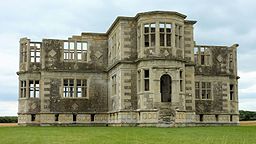Lyveden New Bield
| Lyveden New Bield | |
| unfinished country house | |
|
The Unfinished Lyveden New Bield
|
|
| Country | England |
|---|---|
| State | Northamptonshire |
| Region | East Midlands |
| District | East Northamptonshire |
| Location | 4 miles west of Oundle |
| - coordinates | 52°27′25″N 0°33′12″W / 52.45694°N 0.55333°WCoordinates: 52°27′25″N 0°33′12″W / 52.45694°N 0.55333°W |
| Style | unfinished summer house |
| Material | Structure constructed from stone |
| Founded | circa 1604–05 |
| Owner | National Trust |
| Visitation | Building has 9 steps to a low entrance. The grounds are partly accessible, grass and uneven paths (Opening times vary, see NT web site) |
| Map Ref: SP9885 | |
Lyveden New Bield (sometimes called New Build) is an unfinished Elizabethan summer house in the east of Northamptonshire, England, owned by the National Trust. It is a Grade I listed building.
It was constructed for Sir Thomas Tresham, the fervent Roman Catholic of Rushton Hall, and is thought to have been designed by Robert Stickells. The exact date is unknown but can be estimated to circa 1604–05, the year of Tresham's death. The New Bield was on the estate of Tresham's second home, Lyveden Manor House, also known as Lyveden Old Bield.
Just as at Tresham's smaller folly Rushton Triangular Lodge, his principal estate, the New Bield has a religious design full of symbolism. Designed on a plan reminiscent of a Greek cross, the facades have a strict symmetry. The building has two floors above a raised basement, with mullioned and transomed windows. Each floor had three rooms with a staircase in the south projection of the cross. The exterior of the building is decorated by friezes of a religious nature. The metopes contain the emblems and motifs found also at the triangular lodge, such as the "IHS" christogram.
The house was obviously meant for occupation, as it has a great hall and parlour on the first floor, kitchen and buttery in the basement, and a bedroom on the upper floor. However, it was probably never intended for full-time occupation. Too close to the main house for use as a hunting lodge, it may have been intended for use as a "Secret House"—keeping a secret house was a custom of the 16th century. Often within a mile of the main house, the secret house was a place where the head of the household would retire for a few days with a minimum of servants, while the principal house was thoroughly cleaned and, bearing in mind the sanitation of the time, fumigated. Similar examples of "secret houses" exist at Leconfield and Warkworth, where their use for this purpose has been well documented.
...
Wikipedia


